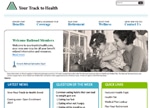Joining their fellow train and engine workers employed by the DeQueen & Eastern Railroad, the company’s yardmasters July 17 chose the SMART Transportation Division as their bargaining representative.
By a two-to-one margin, the yardmasters opted for SMART TD.
Train and engine workers employed by DeQueen & Eastern Railroad voted June 20 to elect SMART’s Transportation Division as their collective bargaining representative.
The employees were formerly represented by the UTU, but their collective bargaining agreement was terminated in 2010 when the railroad’s former owner, Weyerhaeuser, sold the company to Patriot Rail.
“It is great to see that these workers sought to return to the UTU and SMART. They never wanted to lose their representation, and we did not abandon them. Their agreement with the railroad was terminated,” said SMART TD Director of Organizing Rich Ross.
Ross commended the hard work of International Organizer Mike Lewis, who led the effort to return the D&ER employees to the SMART TD fold.
Lewis thanked Arkansas State Legislative Director Steve Evans for his assistance throughout the organizing drive.
D&ER and Texas, Oklahoma & Eastern Railroad are two connecting railroads that operate as one over a total of 91 track miles in southeast Oklahoma and southwest Arkansas. They interchange with BNSF Railway via the Kiamichi Railroad at Valliant, Okla.; Kansas City Southern in DeQueen, Ark., and Union Pacific at Perkins, Ark.
D&ER hauls around 35,000 rail carloads a year, primarily forest products, gypsum board, grain and paper.
 WASHINGTON – Airline pilots spend nearly all their time monitoring automated cockpit systems rather than “hand-flying” planes, but their brains aren’t wired to continually pay close attention to instruments that rarely fail or show discrepancies.
WASHINGTON – Airline pilots spend nearly all their time monitoring automated cockpit systems rather than “hand-flying” planes, but their brains aren’t wired to continually pay close attention to instruments that rarely fail or show discrepancies.